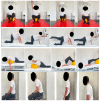The Effect of a Comprehensive Corrective Exercise Program on Kyphosis Angle and Balance in Kyphotic Adolescents
- PMID: 36554002
- PMCID: PMC9778671
- DOI: 10.3390/healthcare10122478
The Effect of a Comprehensive Corrective Exercise Program on Kyphosis Angle and Balance in Kyphotic Adolescents
Abstract
This study aimed to investigate the effects of a comprehensive corrective exercise program on the kyphosis angle and balance in kyphotic adolescents. A total of 62 male adolescents (between the ages of 10 and 18, mean BMI 21.7 kg/m2) with a thoracic kyphosis (TK) angle of ≥ 50° were divided into three groups using the simple randomization method: CCEP (comprehensive corrective exercise program), TEP (thoracic exercise program) and control group. The CCEP program consisted of corrective exercises plus postural perception training (PPT). Exercise programs were applied for 40−50 min, 3 days a week for 12 weeks. The kyphosis angle was measured using a flexible ruler, and balance was assessed using the Romberg index obtained from pedobarography. After training, a highly significant reduction in the kyphosis angle was observed in the CCEP and TEP groups (p < 0.001). Comparison among the groups showed a greater reduction in the kyphosis angle in the CCEP group (p < 0.020). Postural perception improved in the CCEP group versus other groups (p < 0.001). Improvement of the Romberg index (balance) was found only in the CCEP group upon within-group comparison (p < 0.001), with no difference among the groups (p > 0.05). The use of postural perception in combination with corrective exercise programs for thoracic kyphosis represents a comprehensive approach, and PPT can increase the effectiveness of the intervention.
Keywords: adolescent; exercise; kyphosis; perception; posture.
Conflict of interest statement
The authors declare that they have no conflict of interest.
Figures
Similar articles
-
The Effectiveness of Exercise Programs in Adolescents with Thoracic Kyphosis: A Narrative Review.Healthcare (Basel). 2024 Jul 29;12(15):1503. doi: 10.3390/healthcare12151503. Healthcare (Basel). 2024. PMID: 39120206 Free PMC article. Review.
-
The efficiency of corrective exercise interventions on thoracic hyper-kyphosis angle.J Back Musculoskelet Rehabil. 2014;27(1):7-16. doi: 10.3233/BMR-130411. J Back Musculoskelet Rehabil. 2014. PMID: 23948845 Clinical Trial.
-
A randomized controlled study of the effect of functional exercises on postural kyphosis: Schroth-based three-dimensional exercises versus postural corrective exercises.Disabil Rehabil. 2023 Jun;45(12):1992-2002. doi: 10.1080/09638288.2022.2083244. Epub 2022 Jun 12. Disabil Rehabil. 2023. PMID: 35694970 Clinical Trial.
-
Effect of adding diaphragmatic breathing to corrective exercises on kyphotic angle and diaphragmatic excursion in postmenopausal kyphotic women: A randomized controlled trial.Physiother Res Int. 2024 Jul;29(3):e2100. doi: 10.1002/pri.2100. Physiother Res Int. 2024. PMID: 38821882 Clinical Trial.
-
Effects of exercise programs on kyphosis and lordosis angle: A systematic review and meta-analysis.PLoS One. 2019 Apr 29;14(4):e0216180. doi: 10.1371/journal.pone.0216180. eCollection 2019. PLoS One. 2019. PMID: 31034509 Free PMC article.
Cited by
-
Association Between Lumbar Lordosis, Thoracic Kyphosis, and Muscle Activations During Different Lower Back Exercises: An Observational Study.Medicina (Kaunas). 2025 May 27;61(6):986. doi: 10.3390/medicina61060986. Medicina (Kaunas). 2025. PMID: 40572674 Free PMC article.
-
Effect of Therapeutic Exercise on the Management of Hyperkyphosis in Adolescence and Young Adulthood: A Systematic Review.Physiother Res Int. 2025 Jul;30(3):e70078. doi: 10.1002/pri.70078. Physiother Res Int. 2025. PMID: 40474601 Free PMC article. Review.
-
The Effectiveness of Exercise Programs in Adolescents with Thoracic Kyphosis: A Narrative Review.Healthcare (Basel). 2024 Jul 29;12(15):1503. doi: 10.3390/healthcare12151503. Healthcare (Basel). 2024. PMID: 39120206 Free PMC article. Review.
-
Comparing two corrective exercise approaches for body image and upper-quadrant posture in schoolgirls with hyperkyphosis.Sci Rep. 2025 Jan 31;15(1):3882. doi: 10.1038/s41598-025-85665-0. Sci Rep. 2025. PMID: 39890832 Free PMC article. Clinical Trial.
-
Comparison of balance and proprioception of the shoulder joint in girls with and without upper cross syndrome.BMC Musculoskelet Disord. 2024 Aug 2;25(1):618. doi: 10.1186/s12891-024-07552-5. BMC Musculoskelet Disord. 2024. PMID: 39095725 Free PMC article.
References
-
- Hertling D.K.R. Management of Common Musculoskeletal Disorders: Physical Therapy Principles and Methods. Lippincott Williams & Wilkins; Philadelphia, PA, USA: 2006.
-
- Yakut Y. Kas-İskelet Sistemi Kinezyolojisi. 1st ed. Hipokrat Yayıncılık; Ankara, Turkey: 2018. Aksiyal İskelet; pp. 317–476.
-
- Lizak D., Czarny W., Niewczas M. The problem of postural defects in children and adolescents and the role of school teachers and counselors in their prevention. Sci. Rev. Phys. Cult. 2014;4:11–18.
LinkOut - more resources
Full Text Sources
Medical




